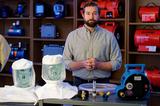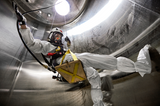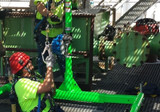Blog
Respirator for Beards: Which Respirators Are Facial Hair Friendly?
It’s almost No Shave November, or Movember as it’s often called, and that means many of your male employees may be sporting facial hair in the weeks to come. Some of your employees may already have thick beards and mustaches, but all that extra hair can be a hazard for those that need to wear respirators on the job, including those that work in construction, mining, and manufacturing. Your employees must wear respirators on the job when exposed to hazardous chemicals and airborne compounds, r
…
Oct 31st 2019
What are the OSHA Requirements for Confined Space Tripods?
Workers across a wide range of industries may need to enter what’s known as a confined space, such as tunnels, manholes, crawl spaces, and other confined environments. Due to the potential hazards of these spaces, OSHA has issued strict requirements for confined space entry. Take a look at OSHA’s requirements for confined spaces as well as the safety equipment used to rescue workers from potential hazards.
What Is a Confined Space?
According to OSHA, a confined space must meet the foll
…
Sep 17th 2019
Gas Detector Tubes: How Do I Read My Gas Detection Tubes?
Gas detection tubes have exploded in popularity over the last few decades. These single-use tubes are designed to record the presence of chemical compounds in the air. Some are toxic, like different types of acid, while others are harmless, such as water vapor.
Just insert the tubes into a hand pump, suck in air through the pump, and read the results to find out if the air is safe to breathe. Gas detection tubes are commonly used to take grab samples in a wide variety of applicati
…
Sep 10th 2019
Ventilation in Confined Spaces and Confined Space Monitoring Requirements
When it comes to working in confined spaces, such as
basements, attics, tunnels, ducts, and pipes, you need to provide a certain
amount of ventilation to prevent respiratory problems and other health issues.
If oxygen levels get too low, you could put the health and safety of your
employees at risk. The Occupational Safety and Health Administration (OSHA) defines
confined spaces as, “[spaces and openings] large enough for workers to enter
and perform certain jobs,” and having, “limited
…
Jun 7th 2019
How to Stay Safe Working in Manholes: Safety Tips & Equipment
Manholes are dangerous places to work, not only because they’re confined spaces, but also because of the danger to health and safety unique to the site. Municipal Sewer & Water magazine published the article
Safety Tips for Working In and Around Manholes, and our safety experts think it has some great advice for workers; here are some things you need to know about manhole safety.
Take Proper Precautions
Never go into a worksite without proper training; be prepared for whatever you fi
…
Aug 27th 2018
The Best Davit Systems for Use in Confined Spaces
A davit is a popular crane-like device made of steel or aluminum and designed for supporting, raising, lateral moving, and lowering people, working platforms, boats, anchors, or other heavy equipment. Davit systems can be used to lower a lifeboat to the embarkation level for boarding. They can be utilized as man-overboard safety devices to retrieve people from the water. You can also see people using davits when they are working on buildings with various terrace levels.
…
Jul 7th 2017
Confined Space Entry — Top 3 Safety Tips
When working in confined spaces, it’s critical that workers stay safe from hidden and potentially deadly dangers. These spaces - which, according to the U.S. Department of Labor’s Occupational Health and Safety Administration, are usually small and difficult to exit - can include places like coal mines, manholes, grain elevators or wine tanks, along with many others. OSHA recognized this and created more confined space regulations in 2015.Why is OSHA Focusing on Confined Spaces?The danger of the
…
Mar 16th 2017
What's Your Rescue Plan?
Be Careful in Confined Spaces
Working in a confined space is dangerous because of the risks of asphyxiation from noxious fumes or dust, reduced oxygen levels, as well as fire and flood dangers. Where can you find confined spaces? Here are a few examples: water and sewer pipes, silos, utility tunnels, pumping stations, tanks, vats, pits, kilns, wastewater wet wells, sumps, vaults, storage bins, crawl spaces under floors, manholes, meter vaults, water reservoirs, boilers, tunnels, and grit ch
…
Jan 11th 2017
Weatherization: Home Safety Issues and Reducing Your Energy Bill
We recently learned about a nationwide program instituted by the U.S. Department of Energy that promotes the use of clean and sustainable energy through weatherization funding. It’s the Weatherization Assistance Program. This came to our attention when a couple of new customers approached us from community action groups that specifically carry out weatherization services. These customers purchased gas detectors for their organizations so we looked into it a bit to find out more and how they a
…
Dec 14th 2016
What's New in the World of RKI Gas Detection?
Gas detectors are essential for confined space monitoring before and after the entry. RKI designs high-rated topside and diffusion gas monitors for these purposes.
Topside Monitors
The
GX-2012 is an active pumped four-gas monitor with sensors engineered to detect Hydrogen Sulfide (H2S), Carbon Monoxide (CO), Oxygen (O2) and combustible gases (LEL). Its powerful internal pump is able to pull samples from up to 50 ft. away! This key feature makes it a perfect topside moni
…
Nov 15th 2016











